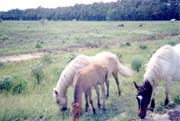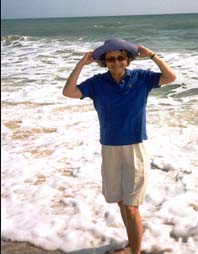Far from the Madding Crowd

Winter at the Island of the Ponies Recharge your batteries amid peace, solitude and wild ponies
by Helena Mann-Melnitchenko

Searching my heart for its true sorrow,
This is THE THING I find to be
That I am WEARY of words and people,
Sick of the city, wanting the sea;
—Edna St. Vincent Millay: “Exile”
The stresses of the upcoming holiday season can make Scrooges of us all. The crowds, the preparations, the long lists, the sniffles deplete our resources, physical and mental. But it needn’t be so. Not if we recharge our batteries in a place where peace, solitude and wild ponies reign.
A mysterious pull draws me to the ocean in all seasons, but even more so when daylight is shortened and the sun does not show its face for days on end.
In November, few people brave the cold wind on the shore. But, as the wit once said, there is no bad weather, just inappropriate clothes. So, bundled up, I take a walk on an island in the Atlantic. The hypnotic breathing of the ocean, like that of a large animal, is balm for the soul. I am far from the madding crowd.
The Ponies of Assateague Island
But not alone. On Assateague Island, just a two hour drive from the Chesapeake Bay Bridge, wild ponies roam. I spy a group of the shaggy ponies, their dwarfed bodies a far cry from the European horses from whom they descended. A dark stallion, a creamy gold mare and several foals meander to the water.
The generations of these ponies have adapted well to the harsh environment on a thin strip of sand, a barrier island, open to the vagaries of the ocean’s wind and tide. Over the years, the wild horses have become smaller, sturdier and shaggier than their European ancestors. No race horses, they are slow and chunky.
A storm brought the horses to this island; some say a shipwreck of a Spanish galleon, others of a pirate ship. The horses bred with early colonists’ horses pastured here so their owners could avoid paying taxes and the expense of fencing on the mainland. Today’s ponies are a mixture of the old world and the new. Thus they come in various colors, from creamy gold to black to large splotches of both.
An Island in Time
The barrier islands of the East Coast, full of stories of hurricanes and pirates, stretch from New England to Florida’s Key West. Assateague Island, among the larger barrier islands, extends for 37 miles, straddling the shores of Maryland and Virginia. It has its own stories and legends, as does Chincoteague, its southern sister island.
The discovery of these two islands by the Europeans was due to a shipwreck. A storm deposited Colonel Henry Norwood and his men on Assateague Island in January of 1650. Of course, Indians knew these slender slivers of sand, and in due time they rescued the Englishmen.
In the early 18th century, when the pirate Blackbeard roamed the length of the Atlantic Coast, one of his numerous wives is said to have lived on Assateague. Later, legend has it, another pirate, Charles Wilson, buried 10 chests of gold somewhere in the area.
Even if the tale of pirate gold is true, it might be difficult to find. Battered by hurricanes and the encroaching ocean, the island has subtly changed its shape, size and position.
Over time, barrier islands migrate closer to the mainland, as if seeking shelter from the ocean. If you study a detailed map of the eastern seaboard, you will find that the tips of peninsulas and barrier islands from Cape Cod to Florida hook toward the mainland. The same is true of Assateague’s lengthening southern tip.
Hurricanes cut inlets in the islands, as did the hurricane of 1933, which severed Assateague Island from Ocean City. Over time, these inlets silt in. The Ocean City inlet, great for fishing and boating, is artificially kept open by dredging and a jetty.
Assateague is unique, for unlike the other barrier islands protecting the coast, it has been spared the developer’s bulldozer. The ponies have the storm of 1962 to thank for the preservation of their habitat, as it was that tempest that proved the island too unstable for development.
Over the centuries, the ponies, too, continued to change, adapting to lack of shelter on the unprotected island, harsh winter weather and the scarcity of plants to sustain large animals.
Living in the Wild
Maryland and Virginia share Assateague Island. The ponies, though all from the same stock, are separated by a fence at the state line. The National Park Service manages the Maryland ponies, controlling the population by vaccinating some mares with a contraceptive. Maryland also manages a state park on the island.
Virginia ponies are owned by the Chincoteague Volunteer Fire Company, which organizes the annual pony penning vividly described in Marguerite Henry’s Misty of Chincoteague. To keep the herd in balance with the island, each July since 1924 the ponies have been rounded up to swim across the narrow channel. Colts are auctioned, and the unsold ponies swim back to Assateague.
The number of ponies on the 37-mile island is kept around 300, divided roughly between the two states. They live in loose herds but usually roam in smaller groups of five to 10. There’s not much shelter on the Maryland side of the island and the ponies live in the open, more so in summer than in winter. Tall loblolly pines, away from the ocean near the marshes, provide shelter in winter and during storms.
The ponies of Assateague Island are used to seeing people, but they are wild animals and will kick and bite. Their lifespan is 15 to 20 years, much shorter than that of a domesticated horse. As they get old, their teeth become worn down by the abrasive salt marsh cordgrass, a large part of their diet. Many die of malnutrition.
The Ponies’ Neighbors
Ponies share their island with other creatures. The island is not polluted, and the ponds provide fresh water not only to the ponies but to their next largest neighbor, whitetail deer, native to these parts. Another immigrant to these shores is the shy, dainty, spotted Japanese Sika elk.
Other natives are harder to spot, although I have caught sight of a red fox skulking in the thicket, no doubt hunting a cottontail rabbit. The raccoon, who hunts at night, leaves its distinctive prints in the soft sand. I have yet to catch sight of the rare Delmarva squirrel. No poisonous snakes inhabit the island, but I have been startled by a hognose, which resembles the highly poisonous copperhead.
Fall and winter are the best times to visit the island, not only for solitude but for comfort. Insects are some of the peskier inhabitants. Unlike the ponies, people don’t have a natural thick coat to protect them from mosquitoes and midges. Only horseflies seem to penetrate the ponies’ shaggy coat. In the summer, I have seen ponies trying to shake them off by rolling on the ground. The ponies also groom themselves and their companions.
Another pest to watch out for even in autumn is the pretty, shiny leaf of poison ivy. On the island it can grow into small trees. This time of year, the leaves turn red and dry, still pretty and still poisonous.
Survival Skills
For those of us on the Western Shore, getting to the island of the ponies is a bit of a drive. Of course, we all go to Ocean City. It’s our summer playground but also a good destination in the winter. The crowds are gone; some hotels and restaurants are closed, but many welcome the winter visitor at very affordable prices.
After a day outdoors, I head for the lobby I bite into a cookie as I sip my tea and watch the ocean through the tall French windows. As the sun sinks into the marsh, I watch a stately blue heron fishing, one of many wintering on the island. Looking up in the brilliant blue sky, I catch my breath as a hawk glides over.
Just eight miles south of Ocean City is Assateague Island’s northern entrance, open all year. I already have a week’s $10 pass; the following day I swing by the island and see the sun rise from the ocean.
Refreshed by nature, I can no longer be Scrooge. I stop at a farm market to buy persimmons. The golden winter fruit is a great delicacy for the ponies of Assateague Island, also. As I feel the persimmon’s smooth skin in my palm, I reflect on the ponies, and can’t help but admire their survival and adaptation skills.
